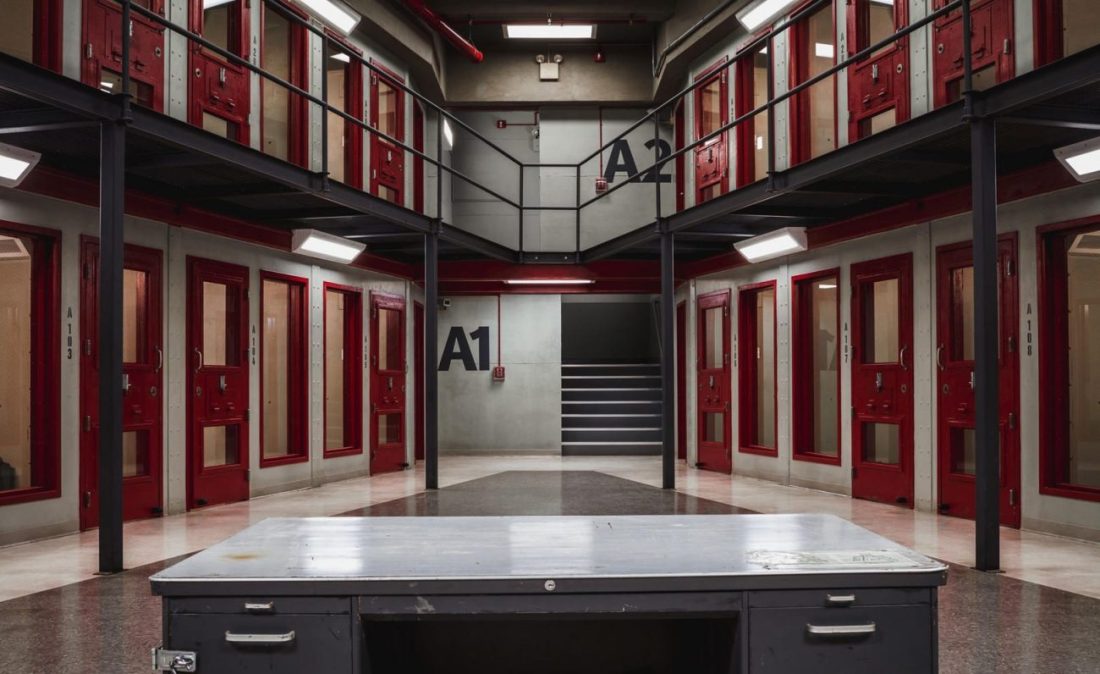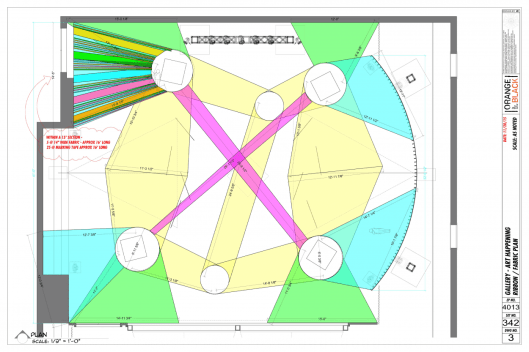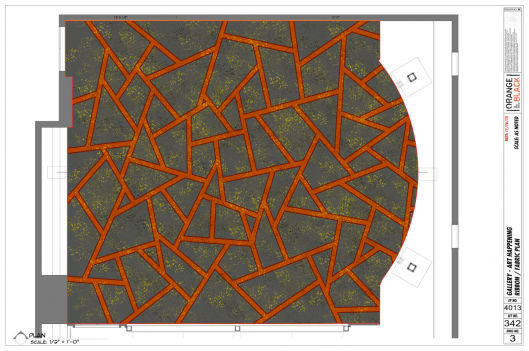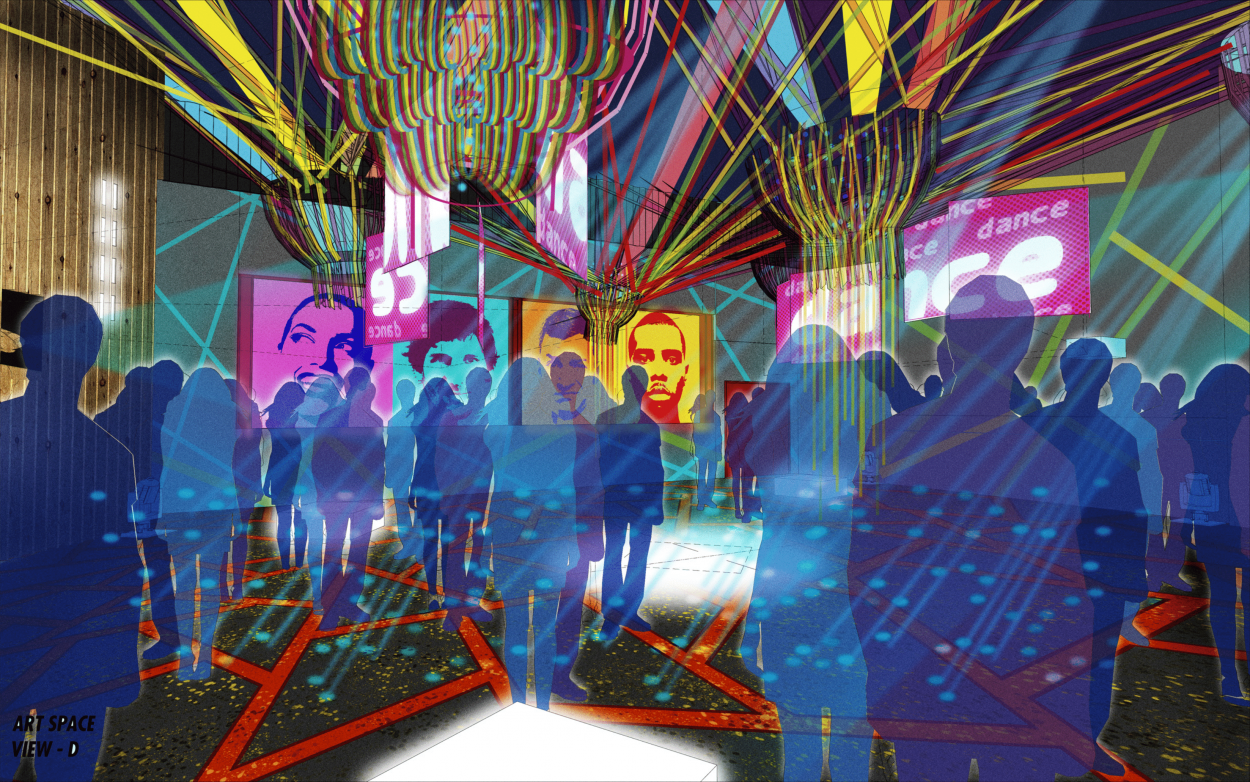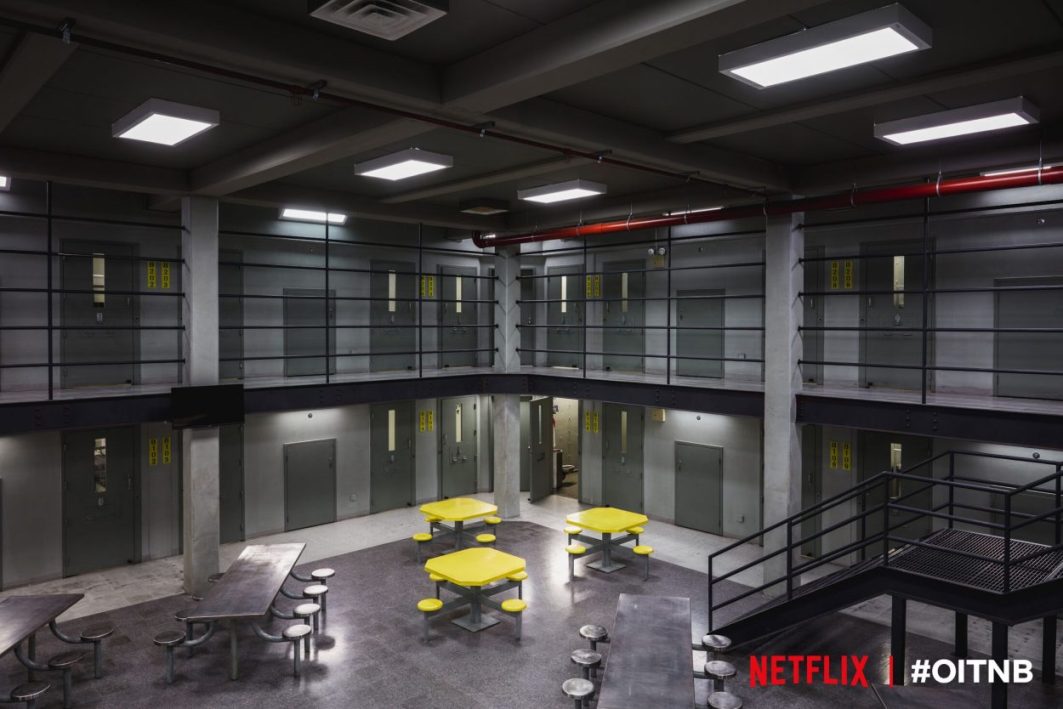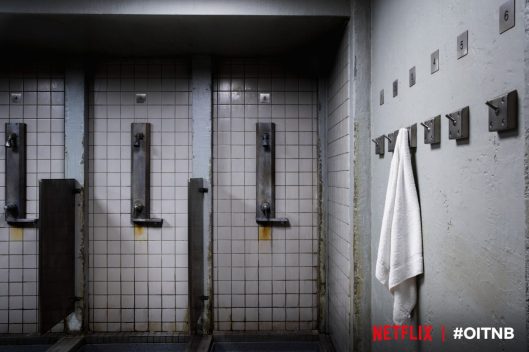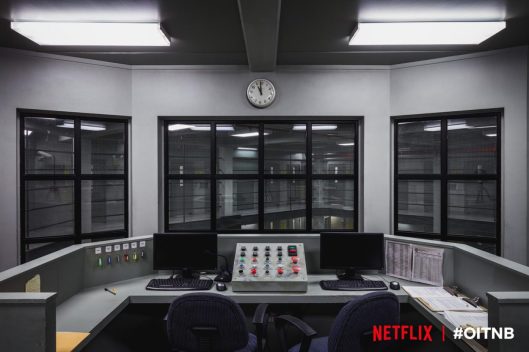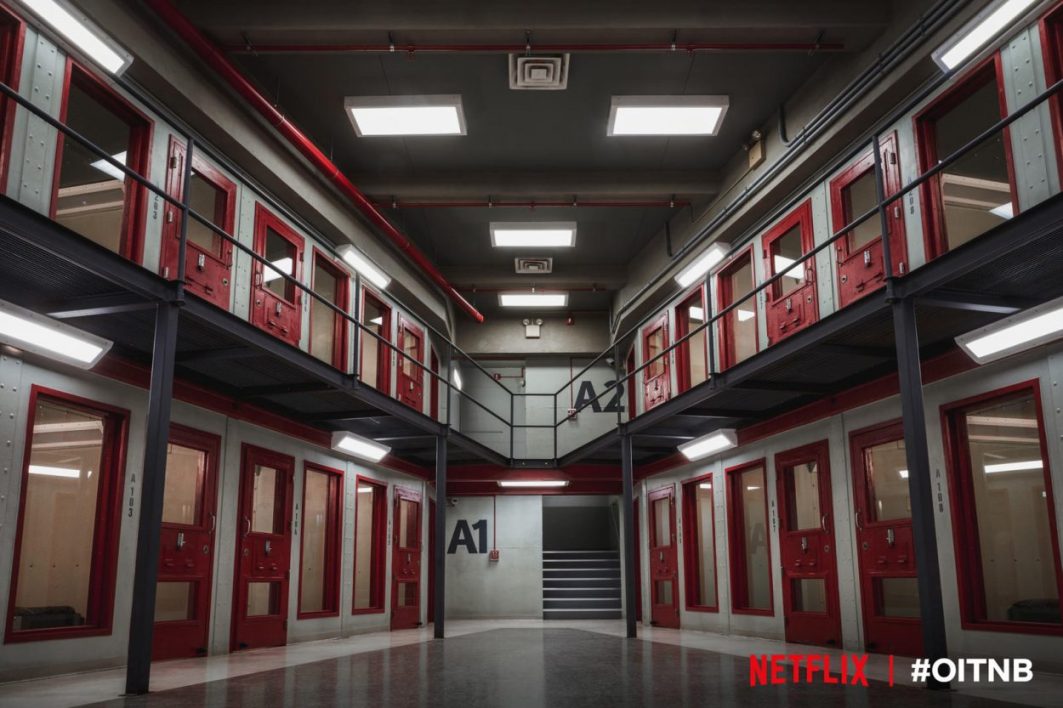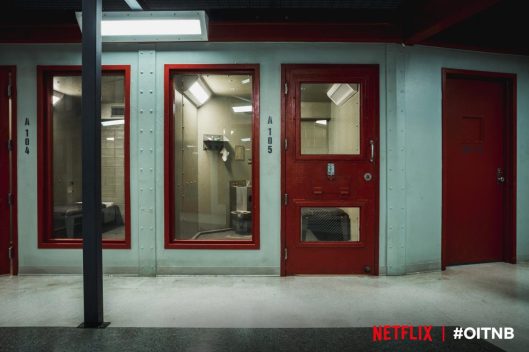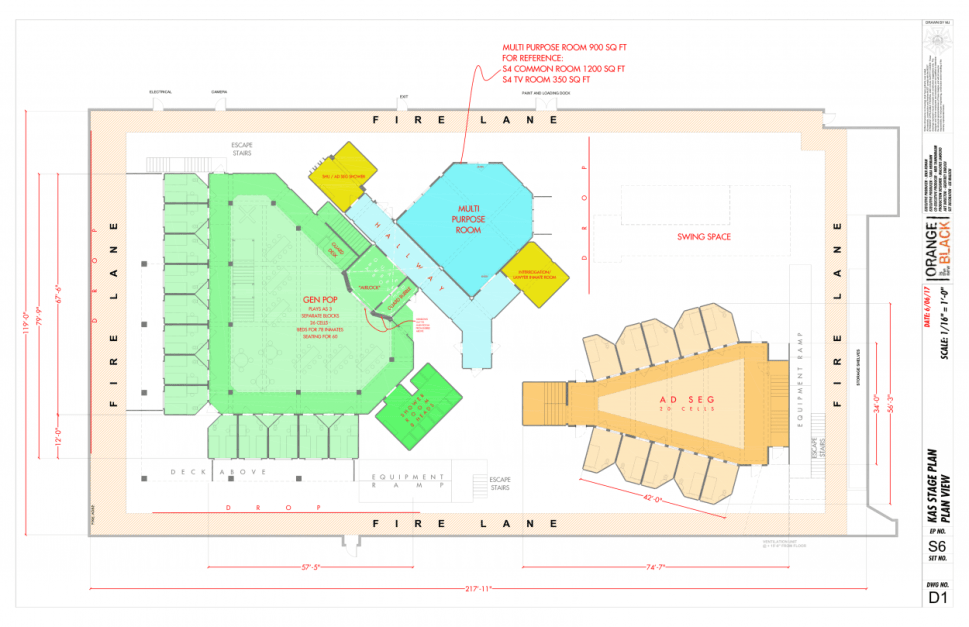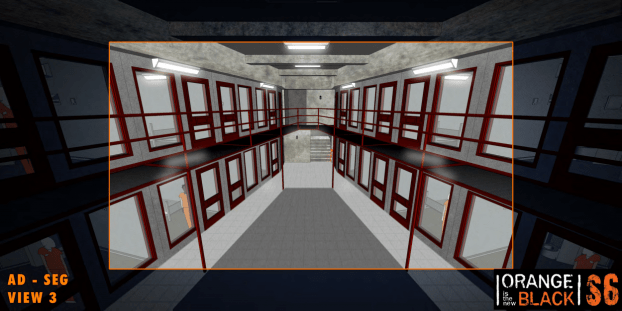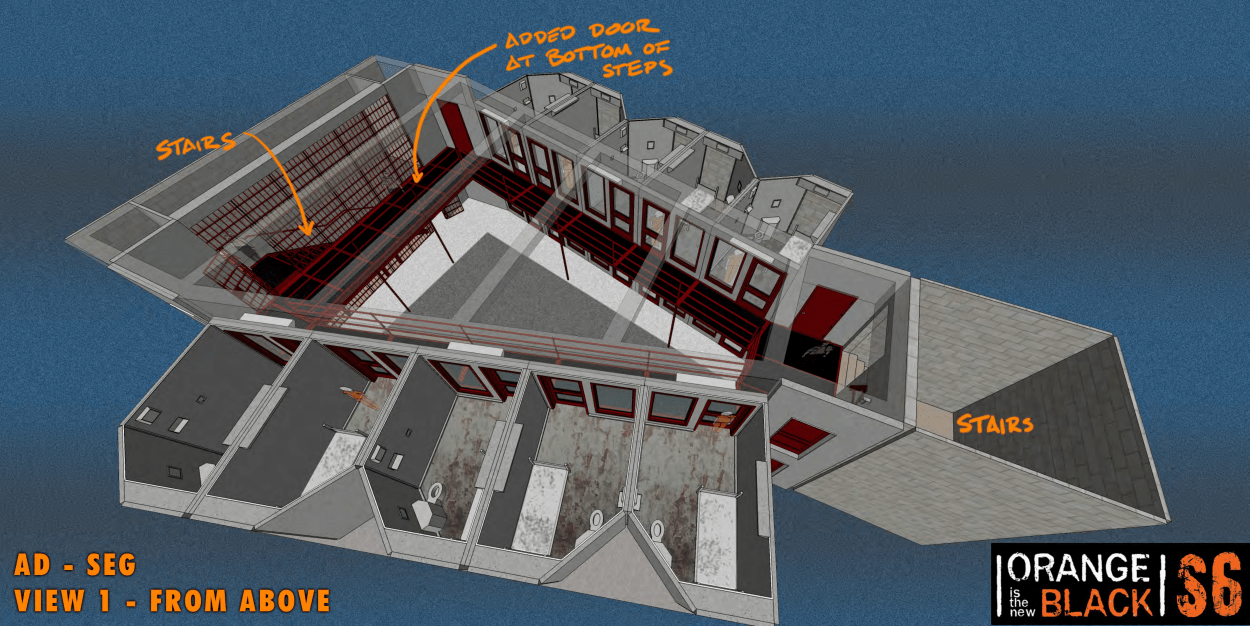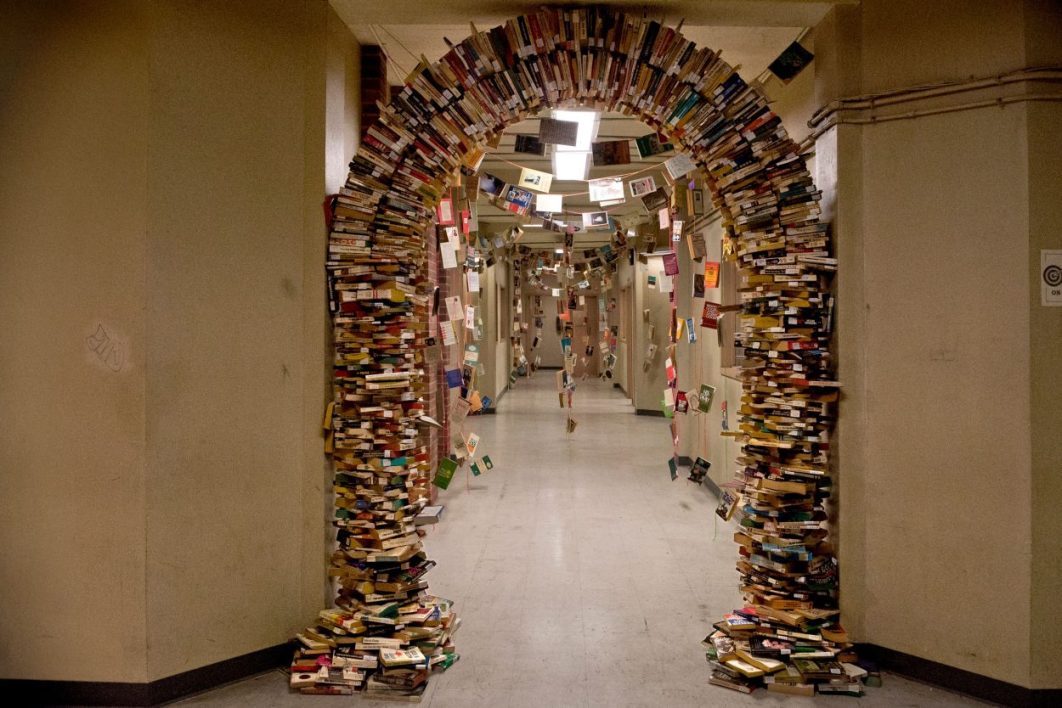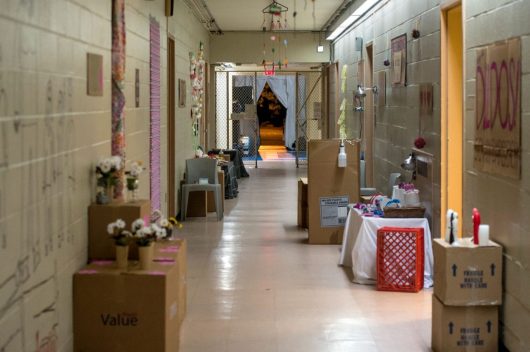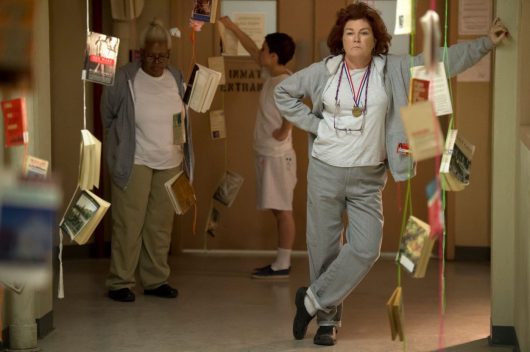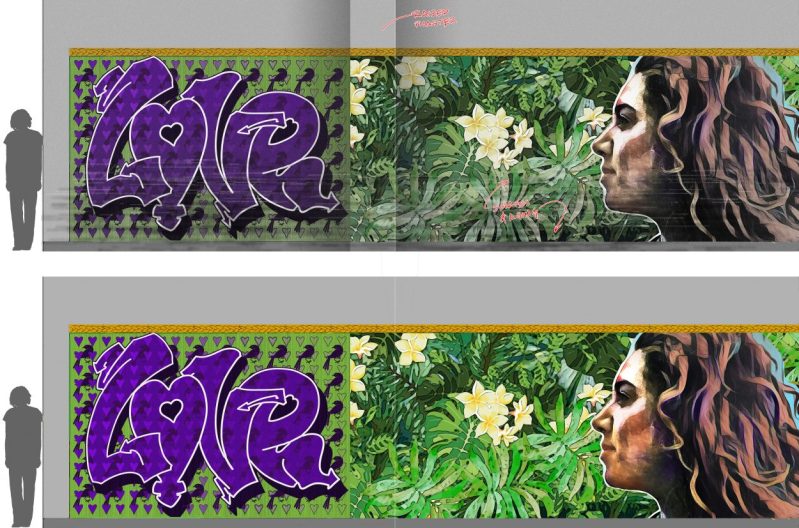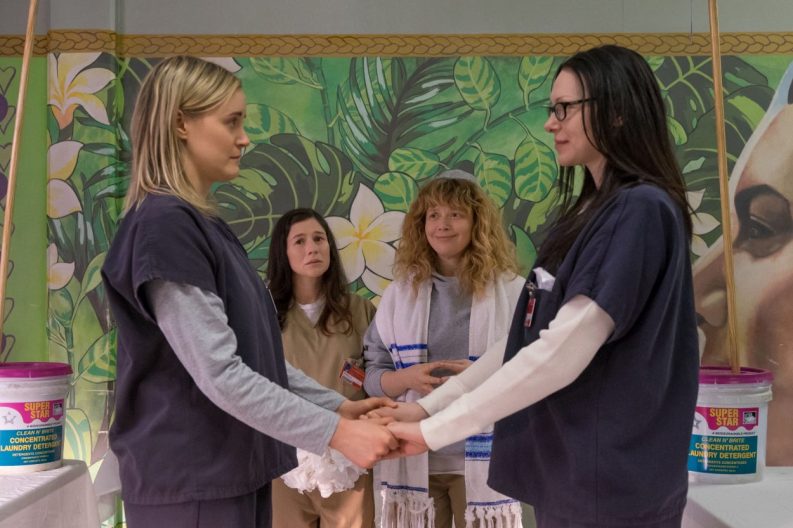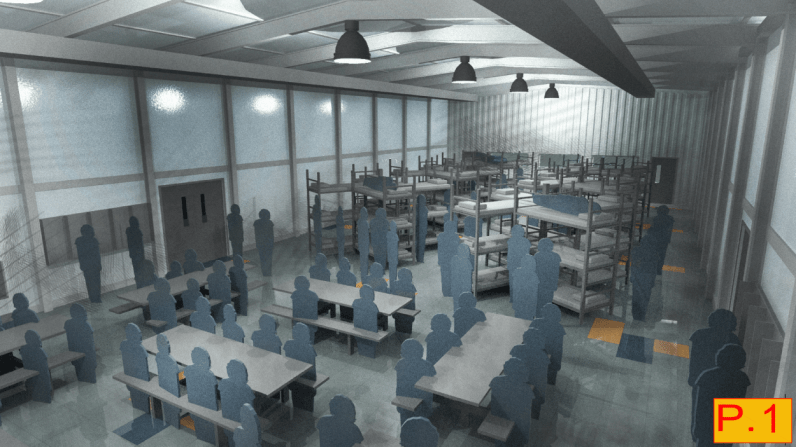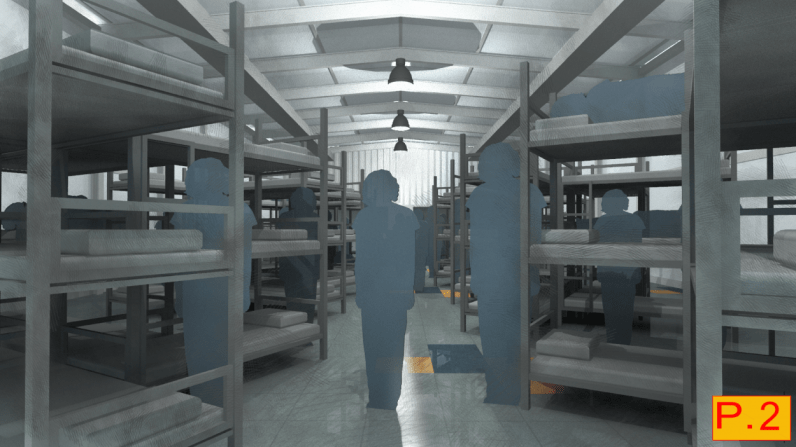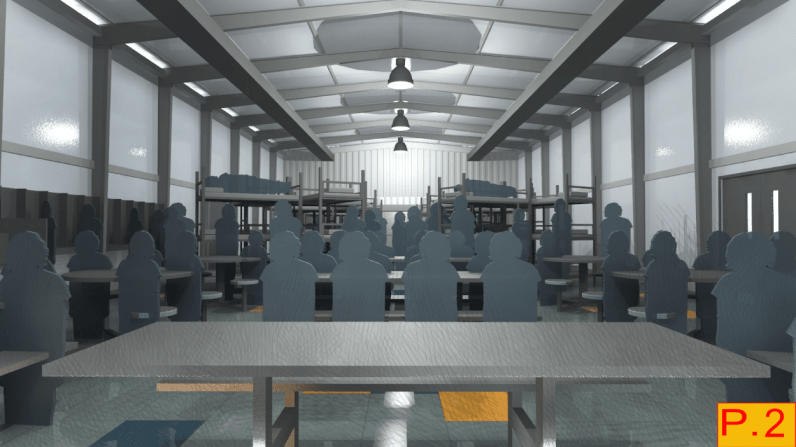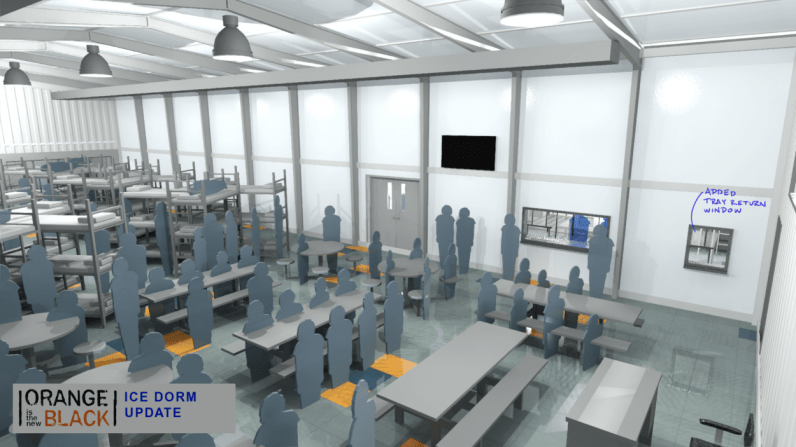Over the summer, I decided to binge-watch every episode of Orange Is the New Black just in time to watch the final season of the show, Season 7. Just after finishing the last episode, I had the exclusive opportunity to dissect the production design of the show in a great conversation with Orange Is the New Black Production Designer Malchus Janocko. Malchus started designing the popular series in Season 4, and together with his team, executed a prison riot revolution with a pool bunker, a beautiful book memorial, an entire maximum security prison, and an ICE detention facility, among dozens of other flashbacks and additional sets.
“We were allowed to do the most amazing things, and they gave us so much free range to come up with great solutions.”
If you haven’t seen Orange Is the New Black, the show is a dramedy based on a true story from Piper Kerman‘s memoir, Orange Is the New Black: My Year in a Women’s Prison, adapted for television by Jenji Kohan and produced for Netflix. The series revolves around Piper Chapman, played by Taylor Schilling, who is sentenced to 15 months in Litchfield Penitentiary, a women’s minimum security federal prison. Piper was convicted of a decade-old crime for transporting a suitcase full of drug money for her ex-girlfriend Alex Vause played by Laura Prepon. In prison, Piper reunites with Alex, re-examining their relationship while Piper and the other inmates attempt to grapple with prison’s numerous inherent struggles.
While the series circles around Piper’s life and circumstances, the show’s strength comes from showcasing how some inmates can move beyond their time in prison while others are captured by the system and unable to progress. OITNB is equal parts bleak and tragic as it is hopeful and funny. If you’ve never seen the show but plan on watching it soon, be forewarned, the show works best in short bursts so you don’t overdose on empathy.
If you watched the show and wondered how they accomplished creating an entire maximum security prison from scratch and accurately showcasing so many vastly different experiences through flashbacks, you’re not alone. Below you’ll be able to see precisely how Production Designer Malchus Janocko and his Art Department, Set Decoration, Construction, and Paint teams created all of these great sets.
NOTE: Spoilers Ahead
Orange Is the New Black Production Designer Malchus Janocko Breaks Down His Sets From a Maximum Security Prison to an NYC Art Party #OITNB Share on X
Interview with Orange Is the New Black Production Designer Malchus Janocko
How did you become involved in the art department and production design?
I went to school for painting at Rochester Institute of Technology and had done some theatre in high school. I got mono when I was at RIT, and I did a theatre show when I was off. That led to me applying to Carnegie Mellon kind of on a whim, thinking I would go into scenic painting because I thought– I actually have a degree in painting, so why don’t I make a living as a Scenic Artist.
I applied there, and they accepted me, but they accepted me as a Scenic Designer. They had not told me that they accepted me as a Scenic Designer. I got there thinking that I was going to be going in as a Scenic Artist, but that was not the case because that program didn’t actually exist anymore, even though it was still in the catalogue. So I made a decision right then and there to stay on as a designer.
So, that’s school, and then I moved to New York after graduating from Carnegie Mellon. I worked at a firm doing set design for corporate events and sports television, and several unscripted, no-story stuff for about 7 years. I did car shows and drug launches, meetings, and other things too.
My friend Jeff Crye, who is the Art Director on Law & Order: SVU, had graduated with me, and he was able to get me a job on a pilot in New York. I then got the opportunity to get a job as an Assistant Art Director for a straight-to-video Wesley Snipes movie that was shooting in Providence, Rhode Island. It was called Hard Luck, which was supposed to be the sequel to New Jack City, but they didn’t have the rights. I did that, and I kind of rolled with that Production Designer, Loren Weeks, for a long time. He’s really one of my biggest mentors in terms of working in narrative television.
I started as an Assistant Art Director on Hard Luck, and then I came back and did a bunch of different things. I worked on the pilot of Mad Men for Production Designer Bob Shaw and Henry Dunn as an Assistant Art Director. Then later, I worked on I Am Legend for almost a year as an Assistant Art Director to Production Designer Naomi Shohan.
Then Gossip Girl is actually how I got back with Loren Weeks, and I worked on Gossip Girl as his Art Director. That was my first job as an Art Director, and then I got to move up as Loren got various pilots at the end of season 3 and the end of season 4. They let me production design the two finale episodes of season 3 and then the four finale episodes of season 4. Loren left after season 5, and the producers Amy Kaufmann, Stephanie Savage, and Josh Schwartz let me step up, which was fantastic.

Did you find the job more difficult as a production designer or was working as an art director just tricky in a different way?
The jobs are very different, as you know. I think I’m actually a very art director-heavy Production Designer if that makes sense. It’s different. I am still art directing occasionally. Last spring, I art directed on Friends From College.
The way the 13-episode series works on Netflix is that there’s too big a gap not to work in-between seasons. So if you want to stay on as the Production Designer on your show, you need to keep yourself available for the next season. I was able to art direct between without having to commit the same kind of time as a Production Designer would. So I still art direct occasionally because of that, although it’s now getting fewer and further between.
But the difference— I love the money side of things and the problem solving of art direction, so I always think that I apply that to the production design as well, which probably makes me production-friendly as a Production Designer. But, yeah, it’s a different set of problems and a whole different amount of interaction with the director and the producers; a whole lot more time in the van scouting.
Did you find it stressful moving from assistant Art Director to Art Director?
No, no. Actually, when I became an Art Director on Gossip Girl, we didn’t have an Assistant Art Director. I continued drawing everything – Loren loves to do these beautiful hand-drawn ground plans and then I would work them up and do the elevations and do all the drafting as well as the budgeting and the schedule.
In the beginning, we were so short-staffed that we didn’t have a full-time graphics person on, so I would occasionally do some of that, too. Being an Art Director without an Assistant Art Director for a show is kind of tough, but you learn a lot of short-hand ways of getting it all done, you know. So your work notes and things aren’t as detailed as they would be if you had an additional person, but all the notes and photographs are still there.
But, yeah, it’s just the addition of handling the money. The thing that was terrifying for me was the first budget for the start-up of Gossip Girl when we did our first big build. That first budget when you become an art director is terrifying. For me, I think it was a million and a half dollars; I had never been in charge of that much money.
I think you just hit the nail on the head right there. Dealing with the money can often be the scariest part of creating sets.
So you finished on Gossip Girl, then moved onto The Carrie Diaries and The Mysteries of Laura while art directing other shows here and there. So from there, how did you end up getting involved on Orange Is The New Black?
Now, that’s an interesting story. I had been production designing on The Mysteries of Laura for the first season, and that was wrapping up when I got a call from Mike Shaw, who was then the Production Designer on Orange Is the New Black. He had been hired on Billions and was looking for an Art Director. So, because he was looking for an Art Director, I realized that Orange must be looking for a Production Designer.
I had worked with one of the Orange Is the New Black producers, Neri Tannenbaum, who had subbed-in on Gossip Girl as our UPM a couple of times, so I knew her from that which was great. I sent her a well-timed email saying I have an entire art department available if you’re looking for someone. I got the callback, and I got to interview.
Neri knew me, so I didn’t have to interview with her, but I got a Skype interview with Jenji Kohan, Mark Burley, and Tara Herrmann while I was on vacation– I had to do it from the beach, which was pretty great. I binge-watched as many episodes as I could before the interview. This was between Season 3 and Season 4. Mike Shaw had finished Season 3. So then I got it!
So, you brought your art department over to Orange Is the New Black from the previous show, and I’m guessing Michael Shaw took his crew with him?
Yeah, I brought my Scenic Artist, Ellen Doak, she came over with us. My Art Department Coordinator went from Art Department Coordinator to Assistant Art Director. Our Art PA went from being a PA to an Art Department Coordinator. But I didn’t bring construction, construction didn’t end up coming – I was asked to keep the same construction department, which was great, and they’re still with me.
So, I’ve moved on to FBI, and I still have Ellen Doak as our Scenic Artist, and our Construction Coordinator, Charles Romanello, has moved on with us. So, it’s nice – we’ve been together now for a long time. I’ve been working with Ellen, my Scenic Artist, for 12 years since she was the Assistant Charge on Gossip Girl. We’ve known each other for a long time.
Who was your Art Director?
On Orange, we started Season 4 and Season 5 with Art Director James Bolenbaugh. He had been there for the first three seasons as the Assistant Art Director. He stepped up, and art directed Season 4 and Season 5, and then he moved out to California to do Westworld and my Assistant Art Director, Geoffrey Ehrlich, stepped up as the Art Director.
So you had a good mix of people who were already there, and crew that you brought in.
We got a new Set Decorator when we came in on Season 4 as well, but our Lead Dresser stayed the same. So it was– it was a really nice mix of people who knew how to make the existing sets work, and who knew the system, plus some new people to bring in some fresh ideas. It was really great.
Had you worked with your set decorator before?
Yes, Kara Zeigon. I had worked with Kara on The Leftovers. I art directed the first season of The Leftovers for Diane Lederman and Kara came in partway through that as the Set Decorator. She and I got along so well that I knew she’d be perfect for Orange Is the New Black. She also comes from a theatrical background, so she was really wonderful for the flashbacks and such.
Unfortunately, she had to leave mid-season in Season 5, but I was able to replace her with another fantastic Set Decorator, Alison Froling. At the end of that season, Alison had a life change and moved to Philadelphia, so I got Lee Malecki, who I worked with on Gossip Girl. She was the Assistant Set Decorator on Gossip Girl. It’s been really nice getting to work with people you know and love continuously.
So this was your first time working with Jenji, right? What was it like working with Jenji? Was it a smooth transition coming in on Season 4 of the show?
Yes, the first time.
We’d send everything up to Jenji, and Tara, and the writer – we always had a writer with us. Usually, the writer would be the voice of Jenji. Jenji would pipe up about anything that she felt strongly about.
Yes. Jenji is so embracing of creativity in general. With all of the flashbacks, the show takes a theatrical approach. All of these little dramatic moments outside of the prison are really asking for a creative and funky perspective.
One of my favourite flashbacks that we did was the season 4 finale, where Poussey Washington dies in episode 12, but we get her back story in episode 13. It’s this spectacular cathartic moment– a wonderful piece of the best night she had in New York City, and we get to breathe as she goes to this party.
Jenji and the team just said from the start of that, “Okay, art department, go wild!” To get stage directions like that in your script is just a gift. We were allowed to do the most amazing things, and they gave us so much free range to come up with great solutions and find cool locations.
We built the art party from scratch on a basketball court over the course of a week and utilized a bunch of old dead stock. The episode before that, we had a giant water tower for this excellent water tower scene. We turned it around and used the backside of the scenery as part of the art installation. We made chandeliers too, which was so much fun.
The brief included the projection of the individual words that everyone would participate in feeding each other and kissing, so we got to make this extraordinary interactive party. It was just so much fun to get to build that, and you know, it was just so different from being in jail.
Yeah, it must have been nice to play with fun colours again that you would never be able to use inside the prison.
Exactly. So that was always the thing; you have this super muted palette in prison, and then you get to break out with all of these flashbacks. It was always so much fun to have colour again.

Orange Is the New Black is quite a different look from the shows you did previously. It must have been quite a change for you to work with such minimal spaces. You kind of have to pick your finishes carefully and make sure every detail is right because you don’t have a lot to play with afterwards.
Right, and coming in on Season 4, we inherited Micheal Shaw’s original sets for the minimum security prison. He had also designed the ‘SHU’ space, the segregated housing, which is ‘down the hill.’
For Season 6, we got to design the whole prison that was ‘down the hill,’ which was the maximum security prison. We wanted to set ourselves apart, particularly with colour there. We’d done a couple of different scenes in Season 4 and 5, starting to head towards grey. That was a whole interesting process of reimagining what the show was, and how it related to the previous 5 seasons.
I really loved the maximum security prison. The red doors were particularly striking coming from, you know, the previous season where they destroyed everything, and now we see the sterile ramifications of their choices.
Jenji had something very specific in mind for the first episode, which is when Suzanne’s mental breakdown happens because she’s off of her medicine. She’s hallucinating these stories about everyone based on what’s actually happening. She sits in the window of her ‘Ad-Seg’ Administrative Segregation Unit prison cell, and she can see out towards all of the other cells. She operates her pretend remote control, turning on and off the lights in the other cells and watching these imagined pieces of television.
That set was designed for what takes place in that first episode and what Jenji wanted for that little piece of time. We found some great research on those sorts of housing units. We wanted to have the officers able to see into every cell in its entirety. The inmates can’t hide, and the officers can make sure that nobody is harming themselves. Everyone is under full surveillance 24 hours a day. What that would do to you mentally worked so perfectly for the story of Suzanne before she is taken to the General Population.

Did you end up visiting different prisons as part of your research?
Yes, my location manager and I went to a bunch of different prisons as we were building, and as we were prepping for season 6. We knew we’d be in a bunch of prison locations to shoot various spaces we weren’t going to build. We wanted an amalgam of them, so it would feel like the exterior location that we would shoot at. Some of the interior areas would work with whatever we built, and it would all feel like a single place, while we were actually shooting in three separate functioning prisons, one shut down prison and our space on stage.
There’s a prison here in New York, in Staten Island, that is owned by one of the companies that help us stage here. It’s a non-functioning prison, so they ended up buying a lot of our set-dressing at the end of our show so that they could re-populate it. It had been empty of all its furniture, so they bought all of our bunks. A lot of shows use that space. There are a bunch of different types of housing units there with big, open spaces like we had in the minimum security as well as segregated and isolation spaces.
So, which sets were in that space?
We used that space for Taystee’s holding cell in Season 6 when she’s in federal court awaiting her court date. We used the exterior of the Staten Island prison for Season 6 kickball. We used parts of it – hallways, for Season 6 where Piper and Blanca are being taken to be released – where Piper gets released and meets up with Cal. That was all done in Staten Island when Blanca gets put on the ICE immigration bus. There’s a lot of hallways there; a lot of different buildings and different types of spaces.
Right, so you ended up building the ‘Ad-Seg,’ and I’m imagining you built B, C, and D?
Yes. B, C, and D were all General Population ‘Gen-Pop’ cell blocks, and that was all one cell block that we redressed for each.
Oh, that’s good. That’s smart – with the signage and finding a way to make that a quick change. You also used different styles of tables and different colours to see the difference between each cell block.
We occasionally had to change over the cell blocks during lunch. We had to figure out how to facilitate this, like, “If we can change over half of it, we won’t look the other way it can work.”
I really liked the colour-coding of signage in the different ‘Gen-Pop’ cell blocks, and I noticed the colour coding of the tables in the yellow cell block. Is there a differentiation in prisons with the table seating, or was that stylized?
Well, as we were developing these cell blocks, we made the decision to use the cafeteria tables that we owned from the former prison, those are the big long silver tables. We knew we were going to do the colour differentiation as our means of setting off each of the individual cell blocks. We also wanted to do colour differentiation in costumes as well as in the dressing to set them apart.
Those three corner tables created a power position in the corner, so a lot would happen there, and important people would sit there. However, we didn’t have the ability to change out all of the tables every time. We kind of figured if we just changed the three tables in the corner, it would give us enough colour differentiation that we’ll always know which cell block we’re in.
As we were doing it, we asked ourselves, “how many things can we change out in between each set changeover when we don’t have enough time.” We had initially thought that we would change out all of the doors so that the doors were the colour change, but that was too much. That was far too much. Like, changing out thirty doors over lunch?
Yeah, that would have been impossible.
With the Ad-Seg set– it has an almost triangular feel. Was that an aesthetic choice for camera and blocking, or are those cells really like that?
Well, that was kind of all of those things. I found this great piece of research where they had designed those kinds of cell blocks so that a single guard, or officer, could see into all of the cells at the same time from one side. All of them are angled in that fashion so you can kind of see everybody all at once. We felt that it looked really dynamic and cool.
So I built a digital 3D model, and I sent it up to California to say, “how do you feel about this?” They wanted to make sure it was two stories— I was really stunned when they asked for two two-story sets. I had assumed a one-story set for Ad-Seg and a two-story set for the General Population, but they wanted two two-story sets, and far be it for me to say no– so that’s fantastic.
So the perspective on that – going along those cells, with the tight end at one side and the big set of bars and steps at the other side, was developed out of a bunch of different research. It sets itself up so that you can really have two guards talking by themselves in the middle of this big room with, you know, 28 inmates, 28 cells.
I really love that set. It had so many different angles, and all of them were beautiful, but entirely fitting in with the goals of each scene.
It’s funny because the Construction Coordinator, not Charles, my guy, but the previous guy, had seen me working on the model and said, “Oh, they’d never want to do a triangular set like that.” And I said, “Oh, Really!” So then it was kind of a challenge!
We had all of the steel decks made for the catwalks, and there are some really nice shots with the guards walking above and tracking through. Phil Abraham did a particularly excellent episode in the Ad-Seg with a couple of crane shots that just tracked through the whole place that really turned out well.
What was your shooting schedule like on Orange Is the New Black? How much prep did you have?
Well, it got longer and longer throughout Season 4,5,6, & 7. When I got there, we were kind of doing this 8, 8 and a half sort of day, doing half of the half-day between one episode and the next. Trying to do a hand-off was difficult, so that turned into 9.
For Season 7, we had a 10-day schedule. So, we’d do 10 days of shooting, and I think we did 8 days of prep. So, we had 2 days to really concentrate on everything that was happening without being out scouting – it was actually a fantastic schedule.
On FBI, we’re doing action scenes and stunts and special effects and explosions, and we’re on an 8-day schedule for 22 or 23 episodes.
Wow, I imagine you will be exhausted by the time you’re done.
Yeah, but you know, there’s never enough time in prep before shooting. You inevitably get pushed back and pushed back, and you’re never done on the first day. You always have something that you’re still building.
That was actually one of the things that happened in Season 6 of Orange. We knew Ad-Seg had to be done for the first day and the first episode, so we got that done, but with General Population, we told them that there was no way we could have it done for the first episode. Of course, it’s right next to the Ad-Seg, so we were trying to build while they were shooting, which was challenging. Once it was done, it was fantastic.
Once you finished the maximum security prison areas, I imagine you were then freed up to focus on all of the flashback sequences. There were so many flashbacks every season, did you find it difficult to juggle those?
The schedule was really quite good with the flashbacks. Of the 10 days, we were on our stages, usually around 6 of those days, I’d guess. I think it was often 6 in and 4 out on location. Sometimes 5 and 5. The occasional episode was 4 in and 6 out. You’re always trying to double up locations, but it was actually pretty good. We were always able to start out with stage days.
There were actor scheduling conflicts naturally, with so many actors in the show, so some scheduling issues would happen every once and a while. It was still pretty good as far as the timing of the flashbacks went. They gave us enough time to prepare the locations and things.

What were your favourite flashbacks to do?
Poussey’s party was great, but I loved Red’s flashback to Moscow in the 80s. I also loved Frieda’s flashback as a kid in Arkansas, at the beginning of Season 5, where we find out that she was a Girl Scout. That was pretty great because there was all this foreshadowing to her bunker and the pool hideout in Season 5. Yeah, those are my favourites. I loved doing Red’s flashback, though. That was fantastic. The factory in Russia.
The exterior facades by the train tracks were so interesting. Where was that?
That’s the Brooklyn Army Terminal. It’s right on the water, and it’s a depot where there are train tracks that come in, and there are these gantry cranes that run the full length of that building that works in tandem with those wild brutalist balconies. The large concrete abutments that stick out are all staggered so that the gantry cranes can pick up stuff off of the trains and drop it onto one side or the other side of those staggered balconies. The warehouse functions as a multi-story crane unit that can lift up to the eighth floor or something like that.
I had scouted that location when I was working as an Assistant Art Director on Dark Tower when Naomi Shohan was set to design that, and Ron Howard was going to direct it. I spent a lot of time there measuring it, and I thought this is precisely where we should do it.
I spoke to our Location Manager on Orange, Stuart Nicolai, and we went there. We knew immediately that was going to be the spot, and we just had to figure out how to make it all work. We were able to do that with a combination of real graphics and visual effects. The giant banner of Lenin was visual effects, but the one in front of it was real. The one that goes across the balcony was still 80 feet wide by 14 feet tall or something like that. It worked out really well.
The book installation in memory of Poussey. Was that written in the script the way it was shot? How did that develop?
The memorial library was written in. I’d like to say that the book arch was written in, but I can’t remember if it was. We had to set it in the library obviously, so our biggest concern was, “how do we make this library particularly beautiful in the space.” We developed it and talked back and forth on how we wanted to execute the entrance for it so that Soso would get her big reveal moment.
Alison Froling was our Set Decorator at that time, and she put in a whole bunch of really great feminist books and historical books throughout the memorial. She’s gotten some notes from different book store owners saying they experienced a spike in particular book sales because of that scene, which was pretty great.
It was really beautiful, and I couldn’t help but try and figure out how you guys got the books so perfectly placed. It seemed like it was really well thought out.
We started out with a full archway going over the hallway, and we had done it with books that were pierced on a piece of metal to make sure they wouldn’t fall down. After the episode was shot, they took out the arch over the top via visual effects. They decided it was too much, even though we had gone through it and shown pictures and renderings and gotten approval on all of it.
They determined that the two stacks of books would be better, which I totally understand because they decided they wanted to knock down one of the stacks of books later in that season. We asked when we started, “Do you need to knock this down?” [laughs]. So we disassembled the archway over the hallway for later episodes, and it became two big stacks, but we did get to rig the stacks so the one guard could knock it over, which was pretty fun.
Brook Soso being taken out by the guards who have stormed in and that slow-motion shot as she’s looking up at the ceiling and looking at the books going by was perfect. That was– you’ve built up this set and created this moment, this perfect storytelling moment, for the end of the season, and it was special.
The mural in the maximum security prison was also really beautiful. Your pops of colour in such a bleak space always worked. Did you have any specific inspiration for that, or did you see that in other prisons?
Yes, there are a lot of prison art projects where inmates are given the freedom to add art to brighten up prisons. A lot of them happen in those kinds of common spaces where you have church services, educational services, counselling, and things like that. We found a wide range of skill levels from just spectacularly detailed, amazingly naturalistic oil paintings, because they have nothing but time, to some really crude and rudimentary stuff.
We thought it would be fun to get some green in there because there’s such a profound lack of green in a maximum security situation, which is why kickball was really so coveted. Getting the green into the space was pretty important, and that was fairly common amongst a lot of the artwork that we saw on the inside of various prisons. We saw a lot of greenery and plant life in the paintings, but we also saw a lot of stylized graffiti and hopeful quotes. We went through several different renditions of this until we eventually landed with the really simple “Love” with the birds.
There’s also this idea of freedom with the birds. I don’t know if you could see the birds on the Love side. There’s this whole gradation of these little bird stencils that turned out really well because we wanted all of those little reminders of freedom within the imagery.

On Season 7 of Orange Is the New Black, you had to do the ICE Deportation Facility. I can only imagine how difficult it must have been to do such thorough research on something as heartbreaking as that. Did you visit an actual facility?
The writers went to the Adelanto ICE facility in California, and every time you would bring it up after they came back, they would quiet down because it deeply affected them. We were given the opportunity to go to an ICE facility in New Jersey, but due to scouting reasons, I was unable to go. My Art Director Geoffrey Ehrlich and my Set Decorator Lee Malecki went, and they eyeballed a lot of stuff for the production design, including the signage and the way things were truly temporary in that facility.
On Orange, with the privatization of this ICE facility and Linda from Purchasing spearheading the creation of this facility, we figured they’d make it quickly with as many pre-fabricated spaces as possible. So you go with something like one of those pre-fab metal warehouse buildings where you can basically just pour a concrete slab, buy it, and they’ll bring the kit, and they’ll put up whatever size shed that you want.
We started with that in mind, but the research for it is just crushing. We spoke to a couple of different attorneys who are representing incarcerated individuals in different places, particularly at Adelanto. They told us about how the big housing units have so many people in them with the showers right in the living space, which keeps the entire area wet and mildewy. The whole space is gross because, with that many people and so few showers, the showers are running all day long, so the whole place is wet and horrible. We put the showers at the one end, and I don’t know that you see them that much in the show, but they are there at the one end.
Oh wow, I don’t think I recognized where they were positioned in the building.
I don’t think people realize when you’re researching darker material, how much it actually affects you. When I was watching the show, I knew you guys must have gone to some facilities because it was almost identical to what I saw on the news. How much did you guys think through the placement of the beds? Was the star-like placement intentional? I saw people online refer to them as swastikas.
That was intentional. I had seen that in the research of a real ICE facility and I couldn’t believe it. The facility was built with these crane shots in mind. We knew we were going to go over everybody with these crane shots, and it gives the ability for the detainees to sit with their heads together and actually talk in a really kind of intimate sort of way in this horrible, horrible space.
The discussions between Maritza and Blanca on the top bunk were pretty amazing, but they also created these little spaces for conversations to happen and to be able to see all the way through the rows. You see rows of things like desks in something like Mad Men, and it’s really great because it gives you this sense of scale, but we tried it that way, and it didn’t work. I was pushing for the star from the beginning. We tried out several variations with renderings on the computer. It really made a big difference.
It made the most sense to keep their heads close together for coverage too. The space felt very authentic.
Everyone would come in for the first day of their prep, and they would say, “This is amazing- in the worst possible way.” It’s tough to compliment people on the creation of something so sinister and awful.
Living with that for several months, for 8 months was really… we’re really happy to not be in that space anymore. It’s heartbreaking that it’s gotten worse since we were working on it. I think we were all very hopeful that things would have improved, but obviously, they have not.
It’s been heartbreaking to watch and read it all from afar.
It’s really one of the reasons I’m the most proud to work on Orange Is the New Black. Jenji and Tara and the writers wanted to address this head-on. Not only with the main ICE facility, but we did the temporary ICE facility where Blanca makes the phone call.
We did it just like they’re doing it in Texas where they don’t have enough space, so they’re putting people in pop-up fencing pens inside of big box stores that aren’t functioning. We found a non-functioning for-rent big box store in the Bronx, and we came in, and we just put up temporary fencing to create the pen.
I remember seeing Pence with the fence and all of these people crammed in there. Even the positioning of the shot was the same except Orange also had fewer people in the fenced area, and that’s what is truly sad about it.
We asked at every point, “how many people do we want to see in here?” For our housing unit, we went for triple bunks because we had seen the overcrowding, particularly in California. The overcrowding of prisons is terrible, and then you see those triple bunks at these ICE facilities, and it’s even worse. It’s bad enough with two but then to put people in three? I was asked if it was a small facility. Someone thought it looked small, and I was like, “No, that room is huge; it’s just so full of people.”
By that point of the show, I was just balling my eyes out. Then by episode 12, when they off Tiffany, I was just gutted- completely empty. I’ve never cried so hard from watching a TV show.
Yeah, I watched four episodes over the weekend with my wife, and you know, I’d been watching chunks of cuts, but I had never sat down to watch a big portion and having watched four, I had to stop. I couldn’t continue. I needed a breath. I’ll continue probably this weekend, but yeah, it’s so much.
That last episode was so redeeming.
Yeah, oh, I’m getting choked up. For Taystee’s character to have come so close to committing suicide and to have turned her own self around; to have found what’s most important in her life and how she can do good in her life every day– that’s just amazing, and Danielle is just spectacular to work with.
Yeah, she’s so good. She’s really something.
And working with Natasha as a director was just spectacular.
Oh, I didn’t realize she directed an episode.
She directed a one-night flashback with the car crash. She and I worked together, I don’t know if you remember this moment, where Lorna is in the bathroom with all the mirrors? That was Natasha with me brainstorming in a ladies room for an hour.
We had seen these round mirrors in a different location that we loved, and we ended up at this location with these stone walls, and we couldn’t actually put our own mirrors up on that surface. So I decided to build a wall there and put up our own mirrors to make this spectacular bubble moment, and I was really pleased with how that turned out. Natasha’s amazing to work with. Russian Doll is one of my favourite shows this year.
What is your process like working with the DOP? Especially working with all those mirrors, but also in general.
Well, our DOP, Ludovic Littee, really embraces mirrors, which is fantastic. He directed an episode in Season 6– the one with the car going into the lake, and he directed one in Season 7 as well. He is a real collaborator, and I really enjoy working with him.
We showed him the renderings of how these mirrors were going to work and the only thing he was worried about was having enough time. We knew it would be a great shot, and it would be fantastic, but this was on a day that we had three other things to shoot. We ended up having a power problem in that hotel that day, so we punted a scene they decided they didn’t need. It was a lobby scene, so they had more time to get the bathroom scene right in the end. I think the lobby scene got punted, but I’m not sure.
You know, production designing is always hard because you never get to stay with the episode that’s shooting, you’re always onto the next episode. I was there to open the set early in the morning, showed them the mirrors, and I don’t think they asked for any tweaks. They just moved in and figured out how to shoot it. All of those mirrors were on hooks so they could gimbal so that they could be adjusted to camera.
Last question: what would you classify as your favourite set on Orange Is the New Black?
I think Ad-Seg was my favourite set. I know it’s weird to have a cell block or prison portion be a favourite set, but I think that we figured out all of these technical issues and all of the aesthetic issues. We managed to get it all in on budget, and we figured out some hardware tricks where we were able to fake some of the prison locks. They looked really good, and they were a tenth of the price. This was part of the Art Director in me. You become really proud if you’ve given bang for the buck and created a full 360 degrees.
We had a little problem in that they asked for the phone bank in that space as an afterthought. That was a challenge, and we had no space to put it. We jammed it into that corner and made it work.
I think the lighting was really good too. All of that is real prison lighting. I thought the red with the grey turned out really well and all of the security lighting, down to the additions of conduit and the way the floor is set up in there. The flooring is set up so that the inmates are supposed to stay on the grey part and not walk out into the middle. There are all of these little subtle things we put into the design that I just felt worked really well. It gave the show a lot of scale and a lot of sadness.
I think that’s my favourite set too. It’s been such a pleasure talking to you about this heartbreaking show. Good luck with FBI!
Orange Is the New Black Season 7 Official Trailer
Be sure to watch the final season and find out how it all ends. I found the show incredibly eye opening and I hope you can appreciate all of Orange Is the New Black production designer Malchus Janocko and his team’s hard work and dedication to this great show.

